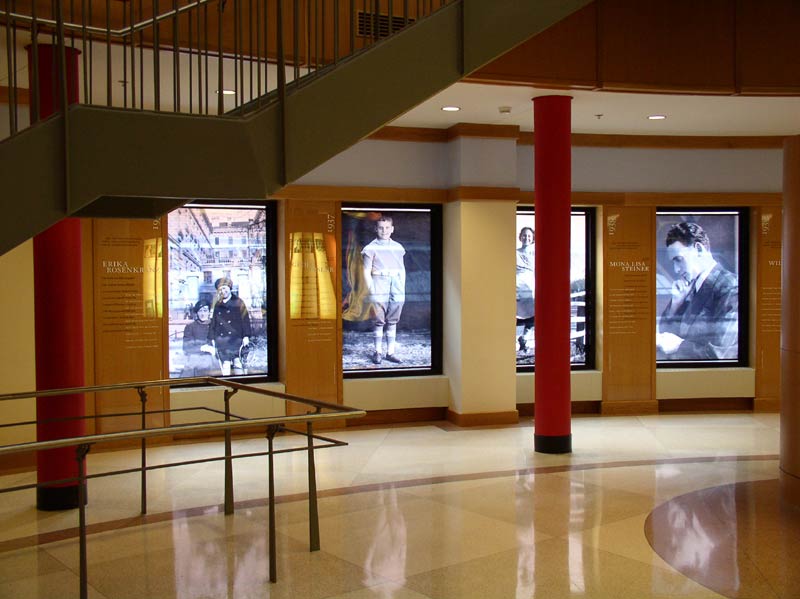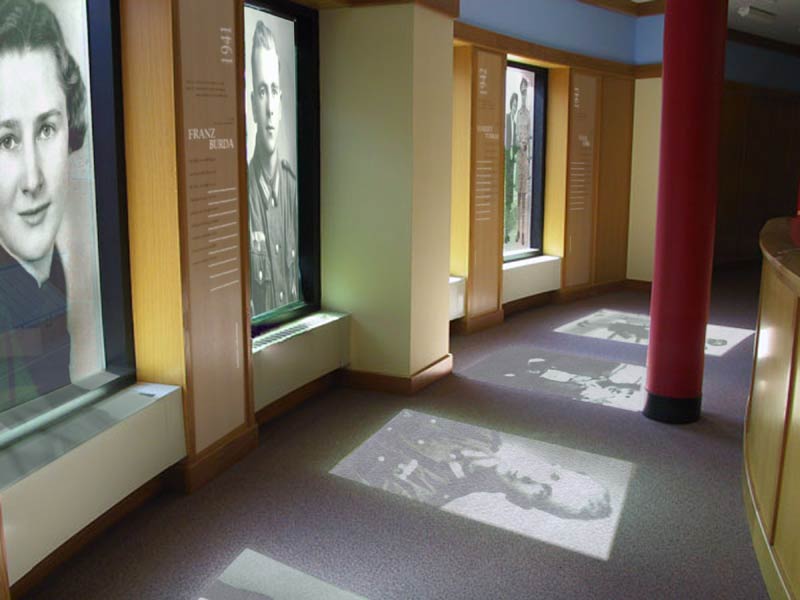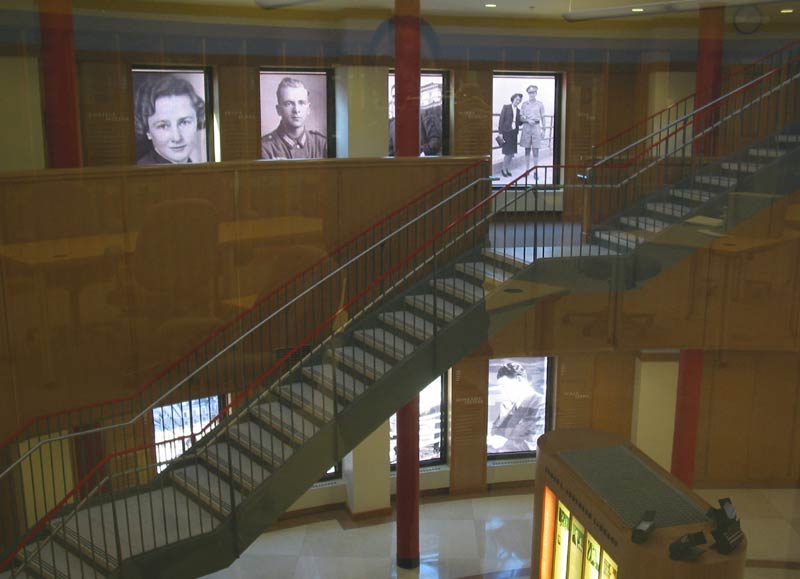Archiving Memory
"The past is never dead; it's not even past." - William Faulkner, "Requiem for a Nun"




In the popular imagination, the idea of an archive may well inspire a vision of an enormous room in a government building, filled with rows of file cabinets, presided over by a bad-tempered Dickensian clerk, and occupied by a few pale-skinned scholars poring over yellowed, crumbling documents. This caricature does no justice to the archives of today, with their climate-controlled environments, computerized records, and interest in going beyond preservation to exhibition and engagement with the general public.
Archiving Memory is a temporary site-specific public artwork that addresses the cultural role of archives and important issues surrounding history and memory. It underscores the significance of photographs in an individual’s life by reminding us of how a person, when threatened by war, persecution, and exile, will take determined measures to save personal photographs. It also stresses the role photographs-and archives-play in cultural preservation, demonstrating how private images and memories can contribute to a shared public sense of history.
Based on an independent collection of personal photographs and interviews from Austrian survivors and resisters of Nazi persecution, Archiving Memory draws attention to the Elmer L. Andersen Library and the archival collections housed there. The Andersen Library is home to eight individual special collections and archives, including the Kerlan Collection of Children’s Literature, the Givens Collection of African American Literature and, of special relevance to this project, the Kann Collection of Austrian History and Culture. Archiving Memory integrates architecture, photography, and the art of display to create a work of public art. In this case that means a work designed for the public, in a public space, at a public university. The net effect is to turn the building inside out by exposing historical materials to view and inviting the public inside, thereby eliminating the sense of an archive as a restricted area and by extension the past as an inaccessible realm.
In an act of creative adaptation, artist Nancy Ann Coyne and her collaborators-the architects William Conway and Marcy Schulte-have opened up the archive by installing large-scale photographic transparencies in the windows so that they are visible from the building’s interior and exterior. Like architect Daniel Libeskind’s Jewish Museum in Berlin, or architect and artist Maya Lin’s Vietnam Veterans Memorial in Washington, D.C., Archiving Memory turns the movement of viewers into a journey both historical and spiritual. Audiences may trace a chronological path by following a progression of images, one for each year from 1936 to 1947, installed in the windows of the library atrium. Oral histories and timelines place the images in a historical context.
The installation of the photographs in the windows transforms the library from vault to projection room, and establishes a free-flowing exchange between interior and exterior, history and the contemporary world, artifact and observer. At night, when the photographs are artificially backlit by the library’s interior lighting, they become subtly visible from outside the building. This complements their projection inward during the day, when the sun illuminates the transparencies and creates secondary images on the building’s corridors. These secondary images provide an allusion to the origins of photography and the work of one of its pioneers, the Frenchman Joseph Nicéphore Niépce. He created one of the first photographic images, circa 1826, by pointing his camera out the window and recording the view of a courtyard. Because of the eight-hour exposure time the position of the sun changed, causing the shadows to change shape; the result was not an instantaneous record but a time-lapse image combining stillness and movement.
Geoffrey Hartman, the noted literary critic and Holocaust scholar, has observed that art is “under heavy pressure when it comes to Holocaust representation, a pressure amounting almost to an interdiction.” Archiving Memory relies not on painting or sculpture but on photography, on images not made as fine art but given new status when incorporated into a work of installation art. “The Holocaust photograph is uniquely able to bring out . . . [the] capacity of photographs to hover between life and death, to capture only that which no longer exists,” humanities scholar Marianne Hirsch has noted. The photographs in Archiving Memory suggest this tension between life and death, present and past. Yet they are not typical Holocaust photographs. They do not show the concentration camps, the piles of corpses or the emaciated ranks of those still alive at the liberation, as in the famous images by the American photographer Margaret Bourke-White and the Englishman George Rodger. Instead, they depict survivors, including some who resisted the Nazis, associated with a single city, Vienna. That emphasis provides a focus within the enormity of the overall subject of the Holocaust and World War II, while the use of portraits humanizes a topic marked by grotesque inhumanity. The façade of the building, temporarily transformed, resembles an enormous page from a photographic album; the association with such a familiar artifact reinforces the sense of shared human experience. The images range from family snapshots to formal studio portraits, and are supplemented with oral history texts that provide a double history, of both the individuals and the photographs, and give the images a personal narrative dimension.
The Holocaust is an acid test for photography as well as history. Photographs, as the French critic Roland Barthes observed, are memento mori, because they require the presence of the subject when made but in the end testify to absence, the passage of time, and, in portraiture, the inevitability of change and death. Whatever their limitations as objective representations or sources of historical knowledge, photographs have been granted a special status compared to other forms of representation because of the so-called reality effect. That has enabled them to play a prominent role in works of art that memorialize WW II and the Holocaust. Christian Boltanski has used personal photographs as central elements in works that are at once memorials, monuments, and shrines. Shimon Attie has projected historical images related to the fate of the Jews on sites in Berlin, Cologne, and Amsterdam, thereby superimposing past on present and conjuring up haunting reminders of loss, with ghost-like images that are insubstantial yet unforgettable.
The images presented in Archiving Memory also draw on the seeming truthfulness of photography as a source of power. The survival of these images testifies to the role of archives in historical awareness, in public memory, in education. Minnesota is distant from the sites where the photographs were made and the events they call to mind occurred, but that does not prevent the Andersen Library from becoming a site of memory and remembrance. The photographs featured are not drawn from the Kann Collection; they were discovered through Coyne’s efforts as an artist and visual anthropologist at a time when there were no archives of such material in Austria. Yet Archiving Memory constructs links between Austria and the United States, the present and the past, that constitute an appropriate demonstration of how archives can participate in a global network of knowledge.
A key question Archiving Memory addresses is how archives can serve as a stimulus for the process of transforming historical documents and other materials into contemporary interpretations, contemporary awareness and action. The Holocaust is moving over the historical horizon, as those who experienced it firsthand are disappearing. Archives serve historical knowledge by storing the instruments of memory-papers, photographs, films, other artifacts-as batteries store energy. These materials only await proper use to generate new awareness and activities.
Archiving Memory serves as an invitation to look through the windows it opens onto history. If the history of the archive is, as historian Antoinette Burton has noted, “a history of loss,” it is also potentially a history of recovery, of at least partial reclamation of the past. Then the archive would be not a static site but a dynamic source, the catalyst for a process of understanding. “To archive” would mean less to file or store away than to bring to light. That idea is enacted by Archiving Memory. The project reveals the truth of Faulkner’s observation not by bringing the past back to life but by keeping it alive, in the present, as proof of the importance of archives and the power of art.